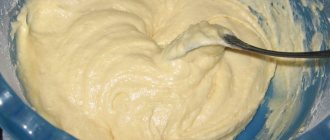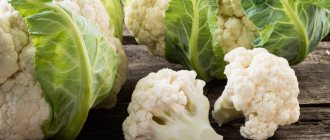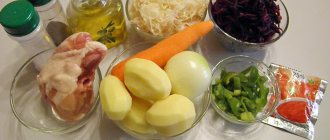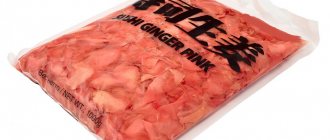Storage temperature
Sauerkraut is best stored at a temperature close to 0 degrees. Of course, temperatures up to 10 degrees Celsius are also suitable for short-term storage. But in this case, the fermentation processes will continue, and the cabbage will become acidic.
Therefore, the ideal temperature would be from 0 to +3 degrees Celsius . This temperature can be found in a refrigerator or cellar. A glazed loggia is also suitable if the mercury column there does not drop below zero.
Freezing
It should be noted right away that the process of freezing and subsequent thawing of sauerkraut destroys a significant part of vitamin C. Therefore, if freezing turns out to be an emergency measure, the product should be eaten immediately after it has thawed.
If this is not possible, for example due to the large volume, then re-freezing the product is strictly not recommended. If you decide to freeze cabbage, it is advisable to freeze it along with the released juice or brine. Or at least keep the brine in a bottle. Why? More on this a little later.
Capacity
If you are going to store sauerkraut for a long time, then you should pay attention to the container in which it is placed. Our ancestors often used oak tubs and barrels for these purposes. This is, of course, a way out.
But a pickled vegetable will significantly lose its unique taste if it sits in a barrel that smells of the dampness of a basement or the unpleasant amber of old wood. Therefore, when choosing a wooden container, make sure that it does not smell and will not spoil the taste of your preparations for the winter.
You should not store pickles in aluminum or steel containers. Oxidation processes will give the food a persistent metallic taste. This is not only not tasty, but also terribly harmful.
The best storage container would be an enamel or glass container. Stop your choice on it!
Storage Features
Store the preparations in a cool place: in the cellar, basement, refrigerator, on a glazed balcony. Ideally, the product is kept in wooden barrels, but few people have them, so most housewives and owners use glass or enamel containers.
The fermented product should not be stored in plastic containers for more than 3-4 days.
If the conditions are met, the shelf life of sauerkraut prepared from frozen heads of cabbage is 2-3 months.
Can sauerkraut be kept warm?
Sometimes housewives have a desire to store sauerkraut in a warm room. For example, in a room or even in the kitchen. Is it possible to do this? You will be surprised, but yes! This is how you can do it. You just have to sprinkle the product with granulated sugar at certain intervals.
This need is due to the fact that granulated sugar, when exposed to an acidic environment, turns into vinegar. It, in turn, protects the cabbage from rotting.
If the pickle is over-acidified, you can also lightly sprinkle it with sugar before serving. Excess acidity will disappear, and all vitamin C will remain.
In addition, if possible, add cranberries or lingonberries to the container with sauerkraut. They remarkably help the workpiece to be preserved for as long as possible without losing its beneficial properties.
The only possible disadvantage of storing pickles in a warm place is the frequent appearance of mold. But this can be avoided.
What to ferment cabbage in?
You cannot find a more suitable container than a wooden barrel. But it is difficult to store it in an apartment, and it will turn out to be too much cabbage. Another problem is that it is difficult to buy a container of the required volume and made of good wood.
A large enamel pan is suitable for fermentation. Make sure it is free of chips. Otherwise, you risk spoiling the cabbage: it may acquire an unattractive gray color and an unpleasant taste.
If you need a small amount of sauerkraut, then glass containers are suitable for this: a three-liter jar or a five-liter bottle.
Under no circumstances should you take containers made of metal, such as aluminum or stainless steel. Typically, during fermentation, the acid reacts with the metal. Cabbage absorbs everything and loses its taste and usefulness. Many people wonder: is it possible to ferment cabbage in a plastic bucket?
Plastic buckets designed for cold food products are now being produced. Some sell fermented milk products, mayonnaise, salted fish, etc. But is it possible to ferment cabbage in a plastic bucket, because during fermentation, acid appears, which, one way or another, reacts with the plastic? Sauerkraut absorbs smell and unknown elements. And buckets are not always made of the right plastic. Other impurities may also be included in the composition. So, by using low-quality containers, we risk not only ruining the taste of the dish, but also our health.
But what to do if there is no other suitable container? Is it possible to ferment cabbage in a plastic bucket? Yes, you can, but you just need to listen to the following recommendations:
- Be sure to buy a plastic bucket for food grade use only. Feel free to ask the seller for a certificate to ensure the quality of your purchase.
- Buy buckets that are not made of colored plastic. It is best to take a colorless one, like a nylon lid for a jar, or a white one, like the one they sell sour cream in stores.
- Wash the new bucket several times. Then fill up with water and leave for a day. Then dry it in the open air.
- You can ferment cabbage in a plastic bucket by placing a plastic bag in it. Use only a food grade bag. Cling film used to cover the inside of the bucket is also suitable.
- You need to ferment the cabbage in a plastic bucket until fully cooked. Then it is better to transfer it into glass jars. Tamp the cabbage and pour in the resulting juice.
Is it possible to freeze sauerkraut? Will it affect the taste?
It's easy and interesting to communicate here. Join us!
In Siberia everyone freezes cabbage, it’s normal.
And I freeze it too, it’s always crispy and tasty when defrosted.
After defrosting, cabbage will not lose its properties. You just need to freeze it once and thaw it too. If you repeat this several times, the cabbage will become tasteless.
I have lived my entire adult life (30) years and still live in the Far North (city of N. Urengoy). This is how cabbage was pickled back then (it was brought from Earth, but it was brought once a year). Defrosted pickled cabbage is a fairy tale when you put it on the table - it was a delicacy. It doesn’t lose its properties, it’s even crunchy. Well, if they write that it’s soft, then these people have never salted it correctly and in such volumes. The most important thing is not to keep it warm for a long time. when you take cabbage out of the cold. I have a daughter (and she is now over 30. She asks for just this kind of cabbage. Although I make salted cabbage just as well, namely the feeling of the smell of frost - that’s the highlight).
. If someone tells you that sauerkraut, after being stored in the cold, becomes “uncrispy and blobby”, “soft and tasteless”, “becomes useless” - rest assured, they do not know how to ferment cabbage. Even though I don’t live in the Far North (my respect to Olga Balabanova), our Siberia is also not the southern coast of the Adriatic. Believe me, no one here is choking on bloated and tasteless cabbage. And they are stored in the cold.
I think she will become nothing at all
You can freeze it, but you won’t like it after defrosting, it doesn’t lose its taste, but it becomes uncrispy and blobby
It definitely won't make her any better.
Can. It will just be soft when it thaws. This is how they used to do it - it froze in a barrel. I remember in the village I chopped it with an ax for dinner)))
It will become soft and tasteless.
everything will be OK. We've been doing this for 20 years, the taste hasn't changed.
In Siberia everyone freezes cabbage, it’s normal.
Basic Rules
Many housewives do not know how to store sauerkraut for a long time, so they usually cook it in small portions. But you can prepare this healthy vegetable in this form in large quantities. It is only important to know a few basic storage rules.
Under certain conditions, this dish will remain edible for a long time.
- First of all, housewives are interested in the question of storage location. The ideal option here would be a cellar. There the appropriate temperature and required humidity are maintained. In addition, the products in the cellar are protected from sunlight. But this option is not suitable for residents of apartment buildings, since they simply do not have a cellar. In this case, cabbage can be stored on the balcony or in the refrigerator.
- Before storing sauerkraut, it is poured with brine and pressed down with a press. Otherwise, the vitamin C in the product will quickly be destroyed. It is better to remove cabbage from the brine right before use.
- Many people think that it is necessary to store cabbage in glass, but in fact it can also be done in metal containers. It is only important that all necessary conditions are met.
- Although the cellar is the best place to store sauerkraut, mold can still grow in it, which can cause the product to spoil very quickly. But experienced housewives know that this unpleasant situation can be avoided, and they use several simple tricks. To prevent the development of mold, you can add cranberries to the cabbage. Some people periodically sprinkle the cabbage with sugar, mustard powder or grated horseradish. You can also put a cloth bag filled with mustard seeds.
Different opinions on pickling frozen cabbage
Different housewives' opinions on whether it is possible to ferment frozen cabbage may differ radically. Some say that frozen vegetables can no longer be used for pickling. They believe that such cabbage, if fermented, will turn out too soft and will not have a crunch. Others have a different opinion on this matter.
Much of the suitability of such cabbage for further pickling depends on the condition of the head of cabbage after defrosting. An important point is how long the vegetable was frozen. And sometimes it happens that only the top leaves of the head of cabbage are frozen. In this case, you just need to remove them and use the rest of the cabbage for processing.
We suggest you read: How to get rid of water in the basement
Storage temperature
Since it is recommended to store the product in places with cool temperatures, we can conclude that the temperature should be as low as possible, but not negative.
It is believed that the ideal temperature at which sauerkraut will be preserved for as long as possible is 2-5 °C.
Many housewives doubt whether it is permissible to leave sauerkraut on the balcony. It's all about what temperature is maintained there. If the balcony is glazed and insulated, most likely it will be too warm for sauerkraut, and the product will soon spoil. And if the temperature there coincides with the temperature outside, then in frosty weather such a storage place is also not suitable. After all, we cannot allow the product to freeze.
Cabbage frozen in the garden: what to do?
Many housewives often do not remove cabbage intended for pickling from the garden until the last minute. Late varieties are used for fermentation. They are cold-resistant and can withstand frosts down to -5 degrees well. The weather is often unpredictable, and you may find that the heads of cabbage freeze right on the vine.
There is no point in cutting them when they are frozen. It’s better to wait a little, because it’s possible that the next day the temperature will be above zero and the heads of cabbage will thaw. With short-term freezing on the root, usually nothing bad happens to them, and they are completely restored to their structure. And already thawed and dried cabbage can be cut, damaged leaves removed and used for further processing.
Advice. After removing cabbage from the garden that has already been frozen while standing, it is better not to delay processing the vegetable for a long time, but to ferment it immediately.
We invite you to read: Why do you need a Smart Plug and how does it work? Main functions
Cold storage
The refrigerator maintains suitable conditions so that sauerkraut remains suitable for consumption for even several months. In this case, there is only one problem - volume. After all, we can put no more than 1-2 glass jars with this delicious delicacy in the refrigerator, which will be eaten much faster than it has time to spoil.
Knowing these simple rules and tricks for storing sauerkraut, you will be able to prepare much more of it than before. This will make your family's diet much healthier and more varied. After all, there is nothing tastier than this dish in combination with boiled potatoes or as a filling for a pie.
- First of all, housewives are interested in the question of storage location. The ideal option here would be a cellar. There the appropriate temperature and required humidity are maintained. In addition, the products in the cellar are protected from sunlight. But this option is not suitable for residents of apartment buildings, since they simply do not have a cellar. In this case, cabbage can be stored on the balcony or in the refrigerator.
- Before storing sauerkraut, it is poured with brine and pressed down with a press. Otherwise, the vitamin C in the product will quickly be destroyed. It is better to remove cabbage from the brine right before use.
- Many people think that it is necessary to store cabbage in glass, but in fact it can also be done in metal containers. It is only important that all necessary conditions are met.
- Although the cellar is the best place to store sauerkraut, mold can still grow in it, which can cause the product to spoil very quickly. But experienced housewives know that this unpleasant situation can be avoided, and they use several simple tricks. To prevent the development of mold, you can add cranberries to the cabbage. Some people periodically sprinkle the cabbage with sugar, mustard powder or grated horseradish. You can also put a cloth bag filled with mustard seeds.
Sterilized sauerkraut
This recipe will allow you to store the product at home without a cellar or refrigerator for several months.
- shredded cabbage – 5 kg;
- salt – 85 g;
- sugar or honey – 75 g;
- bay leaf – 5 pcs.
Preparation
- Clean the head of cabbage from green leaves and cut out the stalk. Shred into thin strips. Add three tablespoons of salt and the same amount of sugar or honey, bay leaf, mix everything well.
- Place the cabbage in clean glass jars or an enamel pan, pressing tightly. A load is placed on top (a plate turned upside down and a jar of water). Keep until ready at room temperature for 3–5 days.
- Place the prepared sauerkraut in prepared, steamed glass jars with a capacity of one liter - three centimeters below the top of the neck. Cover the jars with prepared lids.
- Place the filled jars in a pan or bucket with water heated to 30 degrees and sterilize for 40 minutes. The water level in the pan should be three centimeters below the neck of the jar. The sterilization time begins to count from the moment the water boils in the pan. The boil should not be violent; the heat should be reduced so that the heating is minimal. Place a wooden grid or a rag at the bottom of the sterilization container.
- After sterilization, the jars are carefully removed from the water using special tongs or a towel. They roll up quickly.
Interesting: How and What to Store Apples in
Prepare according to this recipe after harvesting in the autumn. Without peroxidation, without changing its taste, cabbage will last on the canned shelf until the summer. Perfect as a side dish for boiled potatoes, porridge, meat and fish dishes, for making vinaigrettes and cabbage soup.
Some housewives take the preparations out onto the balcony in the cool season. This is convenient to do if the balcony is well insulated and there is a closet there. In severe frost, the jars will still have to be brought into the apartment. If cabbage is stored in an enamel pan, it can be left on the balcony during frost. But when defrosting, such a product must be eaten as quickly as possible, which is not always possible.
Failures when sauerkraut: 6 mistakes that every second housewife makes
What is cabbage soup without sauerkraut? It seems that preparing the main ingredient of your favorite first course is as easy as shelling pears. However, when fermenting, housewives sometimes make mistakes that can significantly change the taste of cabbage and shorten its shelf life.
Knowing the main mistakes made when sauerkraut, you will never make them
Only properly fermented cabbage retains all its beneficial properties and vitamins until spring. To prepare it, it’s best to use good old white cabbage. Red cabbage varieties may have a slightly bitter taste after fermentation. In Galina Kizima’s “Great Encyclopedia of Gardeners and Gardeners from A to Z,” you will find useful recommendations for growing cabbage and tips for preparing it for the winter.
Useful tips
Sauerkraut is a valuable and healthy product. With its help you can diversify your family's winter diet. But for this you need to preserve the white vegetable.
Useful tips to help you do this:
- The preparation is stored well if heads of late-ripening and late varieties of cabbage, which were caught by the first frost, were used for fermentation. This preparation contains a lot of starch and sugar, so the vegetable turns out richly tasty and crispy.
- Features of the premises. The places where sauerkraut is stored should be cool and dark. It should be remembered that the sun's rays destroy vitamins and the vegetable darkens.
- In containers that are stored at a temperature of +1 - +5 degrees, there should always be brine above the chopped vegetables. Otherwise, the top layer of cabbage will become unusable and will have to be thrown away.
- Preparing containers. It is clear that any utensils must be clean and sterile. How to prepare jars for storing vegetables has already been said. If you use pots or barrels, you can resort to grandma's method. Sprigs of honeysuckle or dill are placed in a pre-washed container and filled with boiling water. The grandmothers still heated the stones and threw them into the barrel.
- Cover the top with a lid. Both dill and honeysuckle destroy pathogenic microflora. In such a container, sauerkraut is stored perfectly and does not become moldy.
- Selecting a container for fermentation. When using enamel cookware, you should be aware that chips and cracks not only shorten shelf life, but also negatively affect the quality of the product.
- Aluminum pans are not suitable for fermentation, as they oxidize. As a result, stored products become life-threatening.
- Plastic containers. You need to choose containers designed for storing food. When plastic comes into contact with acid, it can release harmful impurities.
- 3 carrots;
- 90 g salt;
- 80 g sugar;
- 5 bay leaves.
- Peel vegetables: remove green leaves from heads of cabbage, cut out stumps. Wash and peel the carrots.
- Chop the forks into strips and grate the carrots on a large-mesh grater.
- Place the vegetables in a bowl, add all the spices, mix well and compact.
- Place a wooden circle or wide plate. Place a jar or plastic bucket of water on top instead of pressure.
- The workpiece is left in a warm room (no more than 25 degrees) for four days for fermentation.
- On the fifth day, rinse liter jars with hot water and soda or detergent and steam. Then put cabbage in them. Leave a space of at least 3 cm from the vegetables to the neck.
- The jars need to be placed in a wide pan, the bottom of which is covered with a towel, and filled with warm water. It should not be to the very top, but to the shoulders.
- Place the pan on medium heat. When the water begins to boil, the temperature is reduced. Cook cabbage suitable for storing indoors for 40 minutes.
- Then the jars are removed and rolled up with metal lids.
Plastic containers
Proper plastic containers must meet safety standards and be intended for storing and freezing food products.
Melamine containers are not suitable for storing workpieces - they are usually not marked and are very toxic. PP, or PP, marking is applied to the safest plastic. It is used to make bottles for feeding children and containers for storing food.
PS, or PS, is also suitable for containers, but such containers should not be heated.
Containers with markings are completely suitable for storing workpieces:
- PET, PETE, or PET;
- HDPE, or HDPE;
- OTHER, or Other.
It is strictly forbidden to use containers marked V or PVC or PVC . This is technical toxic plastic. You should not freeze the product in boxes marked LDPE, or MDV.
On the balcony
If there is a stable minus temperature outside and the balcony is not glazed, then cabbage can be stored there, divided into portions . In the southern climate, it is not recommended to keep the workpiece on the balcony: in winter the temperature can rise to +7 and even +10°C and drop to serious frosts. With such unstable weather, it is difficult to predict whether the harvest will survive the winter or will be lost due to constant temperature changes.
In the apartment on the balcony
In urban environments it is difficult to store containers of sauerkraut. After all, the temperature in it is much higher than ideal. Of course, in winter the contents of a bucket or pan freeze, but this is not a problem for a white vegetable.
In order not to get a frozen product every time, just loosen the cabbage, then it will be easy to pick up. Thaw enough vegetables to be eaten within 2-3 days.
In old houses, “cold cabinets” have been preserved under the window. This is a great place to store pickled white vegetables for several days. There is no light in this place, the temperature and humidity are ideal for storing not only cabbage, but also other winter preparations.
The most common mistakes when sauerkraut
Kept at room temperature
For fermentation, three to four days at room temperature (+22...+24°C) are enough, and then the cabbage should be transferred to a cool or even cold place. This snack is especially good if stored in the cold. Take the right amount, defrost it - and enjoy its wonderful taste!
During fermentation, the resulting gases are not released
The cabbage layer must be pierced through its entire thickness with a knitting needle every day. Better yet, dump all the contents into a bowl, mix with your hands and put back into the container for further fermentation. It is enough to do this procedure once, 2-3 days after fermentation.
Didn't use oppression
Cabbage cannot be fermented without oppression (like mushrooms). The entire contents of the container must be completely immersed in brine.
Didn't add salt
Lack of salt can cause failure. For proper fermentation, you need to take one tablespoon of table salt (30 g) for each kilogram of cabbage .
Use iodized salt
You cannot use iodized salt (not only for sauerkraut, but also for all other preparations)!
Recipes - how to pickle or ferment frozen cabbage
If only the top leaves on the heads of cabbage are frozen, this will not affect the taste and beneficial properties in any way, but they are removed during preparation.
If the cabbage is completely frozen, the pickled vegetable will become soft, with a less pronounced taste, and the appearance of the pickled product will resemble porridge. If a vegetable has been frozen and thawed several times, almost all its beneficial properties will be lost.
There are many recipes for fermenting frozen heads of cabbage. We offer the most popular and easy to prepare.
When using any recipe, adhere to the general rules:
- Late varieties are planted/purchased for pickling;
- choose elastic heads of cabbage, without cracks, damage and signs of rot;
- do not use iodized salt - it will soften the vegetables even more;
- Do not ferment in aluminum containers - under the influence of acid, it releases substances harmful to the body.
Housewives sometimes wonder whether cabbage needs to be specially frozen before pickling. This procedure will not improve the taste of the finished product and will negatively affect its characteristics: the cabbage will not be crispy, slippery, or soft.
Simple Ambassador
For simple salting you will need 3 kg of cabbage, 90 g of carrots and 3 tbsp. l. salt.

Cooking method:
- Heads of cabbage are being chopped.
- Grate the carrots on a coarse grater.
- Mix vegetables and add salt.
- Mash the mixture with your hands until the juice comes out.
- After the juice has been released, the vegetables are placed in jars.
- Cover with gauze and leave in a warm place for three days. The workpiece is pierced twice a day to release gases.
- Transfer the finished product to the refrigerator or cellar.
With vegetables
For sourdough with vegetables you will need:
- 1 kg of white cabbage;
- 1 kg of cucumbers;
- 1 kg of sweet pepper;
- 1 kg of tomatoes;
- 2 kg carrots;
- 1 pod of hot pepper;
- 0.5 kg of green onions;
- 6 tbsp. l. salt.
We suggest you read: How to preserve parsley for the winter at home in the refrigerator
Preparation:
- Shred cabbage.
- Grate the carrots on a coarse grater.
- Cut the cucumbers lengthwise into 4 parts, and the tomatoes in half.
- Remove the seeds from hot peppers.
- Everything is mixed, salted and placed in jars.
- Press down on top with a weight and leave for a week at room temperature.
- The finished cabbage is stored in a cool place.
Spiced
You will need: 4 kg of cabbage, 120 g of carrots, cumin (to taste), bay leaf (to taste), allspice (to taste), 100 g of table salt.
How to prepare:
- Shred the heads of cabbage and add grated carrots.
- Mash the mixture, stir and add salt.
- The bottom of the dish is covered with leaves and the vegetable mixture is laid out.
- Add spices and compact tightly.
- Pressed down with a load. Make sure that the brine always covers the cabbage.
- Place the container in a warm place for 6-7 days.
- The finished product is stored in a cellar or refrigerator.
With sugar
Take 3 kg of cabbage, 90 g of carrots, 3 tbsp. l. salt and 1 tsp. Sahara.
Preparation:
- Shred the cabbage and add grated carrots.
- Mix everything, add salt and sugar. Knead the mixture with your hands.
- Transfer the mixture into jars. Press down on top with a weight and place in a warm place for three days. The preparation will have a sweet and sour taste.









